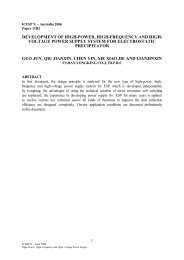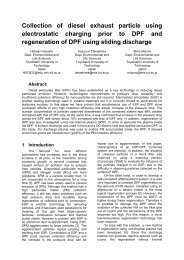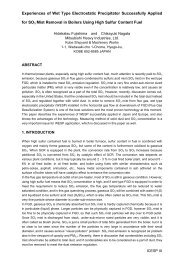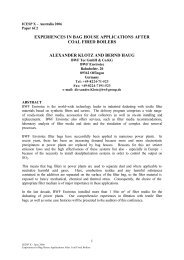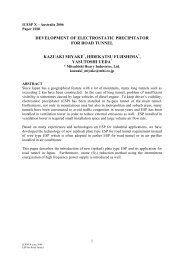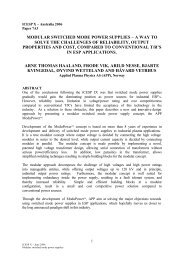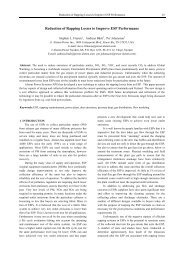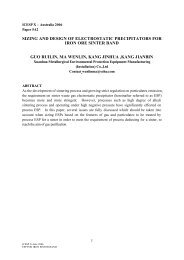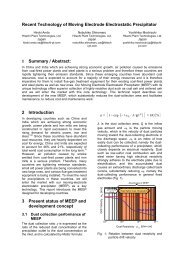Electrostatic precipitator performance in indian pulverized coal - isesp
Electrostatic precipitator performance in indian pulverized coal - isesp
Electrostatic precipitator performance in indian pulverized coal - isesp
You also want an ePaper? Increase the reach of your titles
YUMPU automatically turns print PDFs into web optimized ePapers that Google loves.
Figure 10: The effect of blended <strong>coal</strong> on resistivity<br />
Some Comments on ESP Performance <strong>in</strong> India due to Use of Low Grade Nn-cok<strong>in</strong>g<br />
Coals <strong>in</strong> Pulverized Coal Based Stations<br />
Based on the many years operat<strong>in</strong>g experiences <strong>in</strong> power stations <strong>in</strong> India it can be mentioned<br />
that for Indian power <strong>coal</strong>s the <strong>performance</strong> of the ESP is <strong>in</strong>fluenced by many factors and <strong>in</strong><br />
practical sense to achieve the 99.9 % efficiency is very difficult. It may achieve the target but<br />
the susta<strong>in</strong>ability is very less. After overhaul<strong>in</strong>g the ESP system works very satisfactorily but<br />
it deteriorates its <strong>performance</strong> very rapidly. This is because of the high refractory nature of<br />
ash and poor heat value of Indian non-cok<strong>in</strong>g <strong>coal</strong> result<strong>in</strong>g <strong>in</strong> over load<strong>in</strong>g on ESP system.<br />
i) Clear<strong>in</strong>g of electrodes: - The <strong>performance</strong> of ESP generally depends on the amount of<br />
electrical power consumed by the system. The highest collection efficiency is<br />
achieved when maximum possible electrical power for a given set of operat<strong>in</strong>g<br />
conditions is utilized <strong>in</strong> the precipitation process. Dur<strong>in</strong>g the operation of ESP, the<br />
applied is reduced by the potential drop across the deposited dust layer on the<br />
collect<strong>in</strong>g electrodes due to current flow<strong>in</strong>g through it. This results <strong>in</strong> the reduction of<br />
the effective voltage which consequently reduces the efficiency. A thick cover of dust<br />
layer on the collect<strong>in</strong>g electrode also leads to unstable operat<strong>in</strong>g conditions. The ash<br />
deposit on the emitt<strong>in</strong>g wires results <strong>in</strong> non-uniform corona. So the efficiency<br />
decreases due to heavy deposits of ash on collect<strong>in</strong>g and emitt<strong>in</strong>g electrodes which<br />
needs efficient rapp<strong>in</strong>g system for both the collect<strong>in</strong>g and emitt<strong>in</strong>g electrodes.<br />
ii) Gas temperatures: - The operation of <strong>precipitator</strong> at gas temperature below the<br />
a. acid due po<strong>in</strong>t ( < 100°C) results <strong>in</strong> :<br />
b. Failure of emitt<strong>in</strong>g electrodes due to stress corrosion crack<strong>in</strong>g.<br />
c. Corrosion of term<strong>in</strong>als.<br />
d. Collection of wet ash on the electrodes leads to formation of hard- to- rap<br />
layers of ash.<br />
e. Difficulty <strong>in</strong> removal of wet ash from the hoppers.<br />
iii) Spark rate: - The operat<strong>in</strong>g voltage and current keep chang<strong>in</strong>g with operat<strong>in</strong>g<br />
conditions. This takes care by the electronic controller unit. Very high flash over rate<br />
results not only reduction of useful power and <strong>in</strong>terruption of precipitation process but<br />
also cause snapp<strong>in</strong>g of emitt<strong>in</strong>g electrodes due to electrical erosion.<br />
ICESP X – June 2006<br />
Indian Power Stations - Problems and Solutions<br />
11



